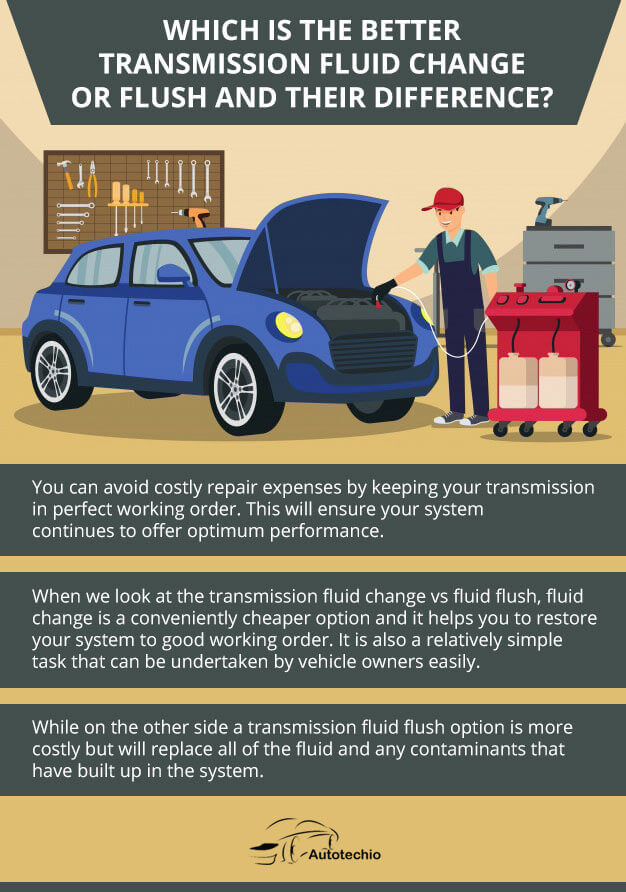Transmission fluid is an important component for every vehicle transmission, which helps in lubrication and it cools the moving parts in the transmission system. Without transmission fluid, these parts would start to suffer from overheating very quickly. But one common question that always comes to our mind, what is better transmission fluid change vs fluid flush. Here in this article, we share the information on the above query.
It is important that you monitor your transmission’s fluid condition and clarity regularly. Carrying out periodically a transmission fluid change vs fluid flush, The buildup of grime and other contaminants can be prevented and you can keep your transmission in perfect working order.
Transmission Fluid Change
You should have knowledge about your vehicle, the color and condition of your transmission fluid can tell you a lot about the situation whether it requires changing. If you are using a used transmission it is mandatory to check your transmission fluid regularly. The new transmission fluid oil looks vibrant red in color. Over time due to the extreme heating of the system and the foreign particles that can make their way through the system. After some time the fluid can start changing its color. If you see that your transmission fluid color is looking dark red, mercury, or similar to brown, it means that it’s time for a change.
Having some initial patience and learning about how to change it is going to benefit you in the long run and transmission maintenance. More importantly, you’ll need a transmission filter kit; they normally contain a gasket for the pan in addition to the new transmission filter and its O-ring. Now you’re ready to get started along with some basic shop tools.
Steps with instructions to change the transmission Fluid
- To raise your vehicle off to the ground, use a car floor jack by using the manufacturer’s recommended lift points to avoid damaging the undercarriage. Exercise caution to ensure no accidents, when using a jack. Always secure the vehicle with jack stands, cribs, and ramps. We recommend you prevent the vehicle from rolling by installing wheel chocks to the opposite end being lifted.
- Then place there a drip or container pan to catch the old oil under the transmission. Before draining the old fluid out, you need to make sure the transmission is at normal operating temperature. Also, make sure there’s a fill spout for the new fluid oil. Some newer transmissions still do away with traditional fill methods.
- To allow for draining, lose the pan bolts. Once you lose, the fluid will immediately gush out. Use caution because the fluid can be hot. Here is a tip to keep things clean: Removing all but the last four bolts at the back of the pan allows fluid to drain with minimal splatter.
- Now replace the transmission pan gasket and filter and make sure the transmission pan and transmission mating surfaces are clean. So that the old filter grommet and transmission pan gasket are removed before installing the new parts.
- Tighten the transmission pan bolts when they are completely drained with the new filter and gasket in place.
- Open the hood to fill new liquid and pull out the transmission fluid dipstick from it. Now, insert a funnel and pour the new transmission fluid through the funnel.
- Now pull the funnel out, reinstall the dipstick and close the hood.
Transmission Fluid Flush
We are discussing here transmission fluid change vs fluid flush. In the transmission fluid changes, it will only replace some of the existing fluid for new and clean fluid. On the other side transmission fluid flush completely removes all old fluid and replaces it with the new. Approximately after every 60,000 miles mechanics recommend a complete flush. However, this may vary depending on the vehicle condition, how you drive, which vehicle you drive, and where you drive.
From the transmission system, all the existing fluid oil pumps out during this procedure. Once it is completely drained, brand new fluid is added. As a result, your transmission system runs much more smoothly.
Which are the better for transmission- fluid change or flush
You can avoid costly repair expenses by keeping your transmission in perfect working order. This will ensure your system continues to offer optimum performance.

When we look at the transmission fluid change vs fluid flush, fluid change is a conveniently cheaper option and it helps you to restore your system to good working order. It is also a relatively simple task that can be undertaken by vehicle owners easily.
while on the other side a transmission fluid flush option is more costly but will replace all of the fluid and any contaminants that have built up in the system.
Summery
Transmission fluid is an essential component for every vehicle for lubrication and cooling the moving parts. These parts would start to suffer from overheating very quickly without it. It is important that you monitor your transmission fluid clarity regularly. In transmission fluid change vs fluid flush, If you see that the color of fluid has been changed, you need to immediately change it. Now you have the option of Transmission fluid change and flush. In the Transmission Fluid change, if you see that the fluid needs to be changed you will only replace some existing old oils but In transmission fluid flush there will be a complete change of all oil in the transmission. Changing the oil helps you to restore your system. In transmission fluid change vs fluid flush, Fluid change is a cheaper option as compared to the Fluid flush. Fluid change is a simple task that can be undertaken by the vehicle’s owner easily.

